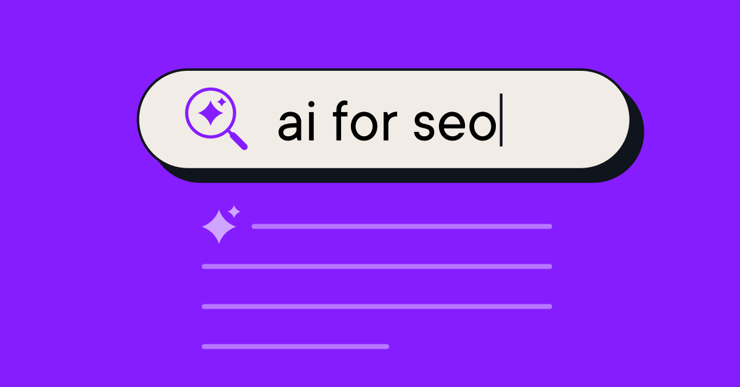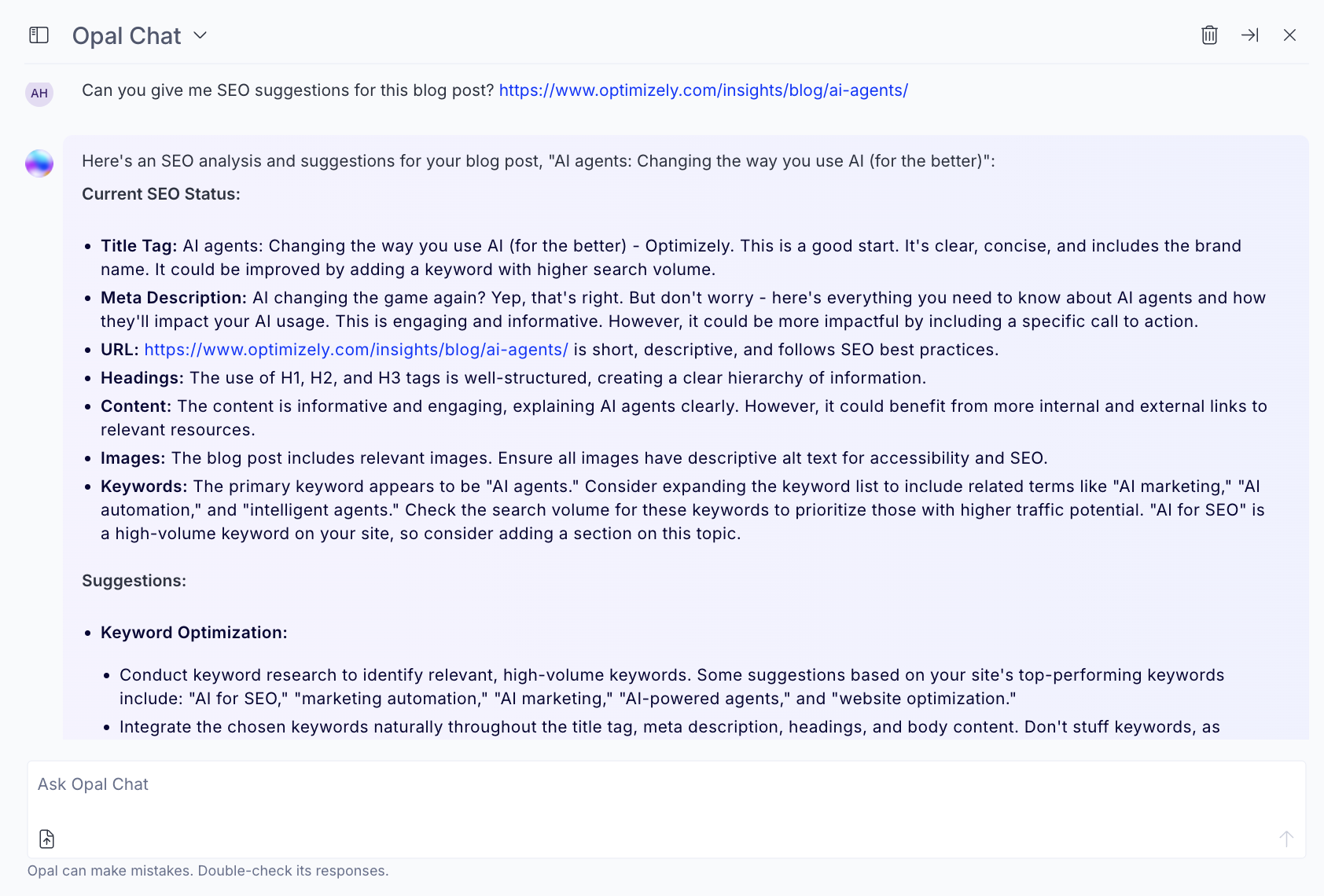
Wenn die ganze Welt (oder zumindest Ihr ganzer LinkedIn-Newsfeed) glaubt, ein KI-Experte zu sein, ist es schwer zu wissen, welcher Meinung man vertrauen kann.
Ja, KI kann in allen Phasen des Content- oder Marketing-Lebenszyklus eingesetzt werden und Ihnen helfen, effektiver, produktiver und kreativer zu arbeiten. Aber es gibt auch einige Dinge, die Sie mit KI nicht tun können oder bei denen Sie sich nicht vollständig auf sie verlassen können.
Im Folgenden werden wir über den Einsatz von KI in der Suchmaschinenoptimierungsprechen - dieDos, die Don'ts und einige der Ausnahmen:
✅ Dos: Wie Sie KI für SEO nutzen
-
Themen- und Keyword-Recherche
Unabhängig davon, ob Sie neu im Bereich SEO oder Content sind oder Ihr Produkt sich in neue Bereiche entwickelt, ist es wichtig, dass Sie sich an der Themen- und Keyword-Recherche beteiligen.
Mithilfe von KI können Sie Themencluster und inhaltliche Lücken identifizieren und auf der Grundlage von Startschlüsselwörtern Vorschläge für verwandte Schlüsselwörter generieren. Dies hilft Ihnen bei der Erstellung eines umfassenden Inhaltsplans für Ihr Team von Redakteuren oder Freiberuflern.
Sie können auch etwas tiefer eintauchen, indem Sie mit Hilfe von KI die Suchintentionen in jedem der von Ihnen gewählten Themenbereiche analysieren, um sicherzustellen, dass Sie alle Antworten oder Meinungen ankreuzen, nach denen Ihre Zielgruppe sucht.
Aber denken Sie daran: Nicht alle KI-Tools haben Zugang zu Google-Such- oder Keyword-Daten, um zu verstehen, was Ihre Inhalte ranken oder wettbewerbsfähiger machen würde. Mehr dazu im Abschnitt 'Don'ts'.
Beispiel-Aufforderung: "Identifizieren Sie anhand des Themas 'Nachhaltige Mode' verwandte Unterthemen und Keyword-Cluster, die den Startschuss für eine umfassende Content-Strategie geben würden. -
Briefings und Gliederungen für Inhalte
Wo auch immer Sie sich im Spektrum der Vermarkter befinden - vom Kreativen im Bereich der Inhalte bis hin zum Techniker im Bereich der Suchmaschinenoptimierung - Sie werden wissen, dass die Erstellung von Briefings für Inhalte eine langweilige Aufgabe sein kann (oder einfach nur ist). Aber Sie wissen auch, wie wichtig sie sind, insbesondere wenn es um SEO oder suchmaschinenorientierte Inhalte geht.
Mithilfe von KI können Sie im Handumdrehen detaillierte Content Briefs für übergeordnete Themen erstellen, einschließlich mehrerer Überschriftenvarianten zur Auswahl oder für A/B-Tests. Sie können das Tool auch bitten, bestimmte Abschnitte zu erweitern oder hinzuzufügen, wenn Sie dies für notwendig halten.
Optimizely Opal ist in die Content Briefing-Funktion der Optimizely Content Marketing Platform eingebettet, so dass dies für die Benutzer sehr einfach ist. Das bedeutet, dass Sie nicht erst kopieren und dann herumklicken müssen, um die gesuchte Registerkarte zu finden. Stattdessen erhalten Sie von Opal Vorschläge, die Sie sofort anwenden können. Gewonnen. 🏆
Beispiel-Aufforderung: "Erstellen Sie mir ein Briefing für einen wettbewerbsfähigen SEO-Inhalt, der auf das primäre Keyword 'eco-fashion' und sekundäre Keywords zielt: 'umweltfreundliche Mode' und 'grüne Mode'". -
Technische SEO-Aufgaben vom Typ 'Geschirrspüler'
Wenn wir von "spülmaschinenähnlichen" Aufgaben sprechen, meinen wir diejenigen, die Sie erledigen müssen... nur nicht wollen. Und warum? Weil es keinen Spaß macht, sie zu erledigen.
Während Sie das Ausräumen und Beladen des Geschirrspülers nicht automatisieren können (jedenfalls noch nicht), können Sie KI für SEO-Aufgaben wie:
👉 Generieren von Schema-Markup auf der Grundlage des Inhaltstyps (z.B. Listen, Rezepte, Produkte & Angebote)
👉 Erstellen von Meta-Beschreibungen (weisen Sie sie einfach an, Ihr(e) Schlüsselwort(e) auf natürliche Weise einzubauen)
👉 Optimierte Alt-Texte für Bilder schreiben und skalieren
👉 Erkennen von Möglichkeiten zur internen Verlinkung innerhalb Ihrer bestehenden Inhalte
Beispiel-Aufforderung: "Erzeugen Sie Schema-Markup für diese Rezeptseite, einschließlich Kochzeit, Zutaten und Nährwertangaben" -
Inhaltliche Optimierungen
Inhalte sollten nie einmalig sein, vor allem nicht, wenn es sich um suchmaschinenorientierte Inhalte handelt. Die Targeting-Schlüsselwörter ändern sich, die Konkurrenten kommen und gehen, die Platzierungen auf Platz 1 kommen und gehen... und kommen dann manchmal wieder zurück.
Aus all diesen Gründen ist die Optimierung von Inhalten ein wichtiger Bestandteil von Content Marketing und SEO. Hier sind die Arten der Content-Optimierung für SEO, bei denen AI helfen kann:
🤖 Vorschlagen von semantischen Schlüsselwörtern zur Anreicherung Ihrer Inhalte
🤖 Identifizierung von Möglichkeiten zur Verbesserung Ihrer bestehenden Inhalte
🤖 Generierung von Variationen der Titel-Tags unter Beibehaltung der Keyword-Intention
🤖 Erstellen von FAQ-Abschnitten auf der Grundlage verwandter Suchen (ein persönlicher Favorit)
🤖 Analysieren Sie Ihre Website auf Vorschläge zur Verbesserung der Conversion Rates
Oh, der letzte Punkt? Das könnte gerade Opal sein. #humblebragGeben Sie Opal eine URL, und da es von der Google-Suche angetrieben wird, erhalten Sie eine vollständige Analyse, wie Sie bestehende Inhalte für Ihre Targeting-Keywords verbessern können.

Beispielanforderung: "Analysieren Sie diesen Inhalt im Vergleich zu den 3 bestplatzierten Seiten und schlagen Sie Optimierungsmöglichkeiten vor" -
Datenanalyse (sehr schnell)
Die meisten von uns lieben es, im Jahr 2025 datengesteuert zu sein - und wenn Sie es nicht sind, steht es wahrscheinlich sowieso in Ihrem Lebenslauf -, aber das Durchforsten riesiger Datenmengen ist nicht immer die schönste Aufgabe. In der Tat ist es ziemlich zeitaufwendig und bereitet uns Kopfschmerzen.
🚨 Spoiler-Alarm: Eine andere Möglichkeit, KI für SEO zu nutzen, besteht darin, sie die Datenrecherche für Sie erledigen zu lassen.
Durch die Eingabe von Traffic-, Keyword- oder anderen Suchdaten, die Sie von anderen Plattformen haben, können Sie KI-Tools dazu bringen, die Kopfschmerzen für Sie zu beseitigen.
Ganz gleich, ob Sie sie bitten, Traffic-Muster aus Analysedaten zu verfolgen, Trendthemen in Ihrer Datenmenge zu identifizieren, Leistungsanomalien zu erkennen oder schnelle Erkenntnisse aus großen Datenmengen zu gewinnen, sie werden die Aufgabe schnell erledigen. Und das Beste daran ist, dass sie sich nicht einmal beschweren werden.
Beispiel-Aufforderung: "Analysieren Sie diese monatlichen Verkehrszahlen und identifizieren Sie mögliche saisonale Muster"
❌ Nachteile: Wo KI für SEO versagt
-
Zuverlässigkeit der Daten
Bevor wir also all unsere SEO-Hoffnungen und -Träume vollständig auf KI setzen, sollten wir darüber nachdenken:
Woher kommen die aktuellen Suchvolumina?
Woher kommen die Metriken der Mitbewerber?
Woher kommen die Ranking-Schwierigkeiten?
Woher kommen die Markttrend-Vorhersagen?
Sie können sich bei diesen aktuellen Zahlen nicht auf KI-Tools verlassen. Sicherlich könnte die KI sagen, dass "nachhaltige Mode" ein hohes Suchvolumen hat, aber ohne aktuelle Daten ist dies nur eine Vermutung.
Zum Beispiel bei der Keyword-Recherche. Sie können nach semantischen Schlüsselwörtern zu den von Ihnen gewählten Themen fragen, aber diese werden aus vorhandenen Online-Inhalten zusammengestellt, ohne dass ihnen Schlüsselwortdaten zugrunde liegen. Opal von Optimizely (Ihr KI-Helfer) wird von der Google-Suche angetrieben, d.h. es nutzt die Artikel mit dem besten Ranking, um eine Liste der wettbewerbsfähigen Targeting-Keywords zusammenzustellen.
Die Lösung: Wenn Sie KI für die SEO-Datenanalyse nutzen möchten, geben Sie regelmäßig Ihre Datenquellen ein (z.B. Semrush Keyword-, Traffic- oder SERP-Daten) - jebesser der Input, desto besser der Output. -
Grenzen der Markenstrategie
Niemand kennt Ihre Marke so gut wie Sie selbst, auch nicht der von Ihnen gewählte KI-Bot. Das bedeutet, dass Sie nicht zulassen können, dass KI Ihre Content-Strategie definiert oder Ihre Markenpositionierung festlegt.
KI kann die einzigartige Stimme oder die Marktposition Ihrer Marke nicht verstehen, wenn sie nicht umfassend geschult wurde. Und selbst mit dieser Schulung können Sie sich nicht darauf verlassen, dass die KI genau das sagt, was Sie von ihr erwarten.
Die Lösung: Umfassende und kontinuierliche Schulungen, um sicherzustellen, dass sie mit Ihrem Produkt, Ihren Geschäftszielen und Trends Schritt halten... oder nutzen Sie die neue Ära der KI-Agenten mit einem Brand Control Agent.Erfahren Sie alles über KI-Agenten in unserem aktuellen Beitrag.
-
Einzigartige Inhalte
Apropos KI-generierte Inhalte und die Notwendigkeit menschlichen Eingreifens: Es ist aus einer Reihe von Gründen wichtig, dass alle KI-Inhalte von einem Menschen überprüft werden:
❌ KI-generierte Inhalte fassen zusammen, was bereits im Internet steht
❌ KI-generierte Inhalte haben keine eigenen Meinungen
❌ KI-generierte Inhalte können manchmal ein wenig... roboterhaft klingen
❌ KI-generierte Inhalte enthalten nicht unbedingt die aktuellsten Informationen
Die Moral von der Geschicht? Vermeiden Sie den Einsatz von KI für Thought-Leadership-Beiträge oder branchenspezifisches Fachwissen. Wenn wir bei dem Beispiel "nachhaltige Mode" bleiben, könnte die KI für einen unterhaltsamen, trendbezogenen Artikel Trends erwähnen, die veraltet oder ungenau sind.
Schließlich müssen Sie Inhalte einzigartig aufbereiten, wenn Sie Wirkung erzielen wollen - und nicht Inhalte wiederkäuen, die bereits online existieren.
Lösung: Bearbeiten Sie von KI erstellte Inhalte immer, um sicherzustellen, dass sie korrekt, wertvoll und bei Google beliebt sind.
KI für SEO Erfolgsmethoden: Eine Schnellfeuer-Runde
- Sorgen Sie für eine klare Prozessintegration: Definieren Sie spezifische KI-Kontaktpunkte in Ihrem SEO-Workflow und dokumentieren Sie, wo menschliche Aufsicht und Qualitätskontrolle erforderlich ist.
- Wissen Sie, wie man richtig fragt: Unabhängig davon, ob Sie eine KI-Prompt-Bibliothek haben (die regelmäßig bearbeitet und ergänzt wird), entwickeln Sie konsistente Prompt-Strukturen für die gewünschten Ergebnisse, die das Team verwenden kann.
- Erstellen Sie eine Checkliste, um qualitativ hochwertige Inhalte zu erhalten: Gehen Sie an alle von der KI generierten Inhalte mit einer Checkliste heran, um die Richtigkeit der Fakten, die Ausrichtung der Markenbotschaft, die Konsistenz der Botschaften, die technischen SEO-Anforderungen, die Absicht der Benutzer, die Differenzierung von der Konkurrenz und all die guten Dinge zu überprüfen.
- Konzentrieren Sie sich auf kontinuierliche Verbesserung und Schulung: Überwachen Sie, wo KI einen positiven Beitrag zu Ihren Arbeitsabläufen und Ergebnissen leistet (und wo nicht), um diese zu optimieren - dazu gehören Zeitersparnis, Qualitätsergebnisse für Inhalte, Auswirkungen auf Rankings, Teamzufriedenheit und allgemeine ROI-Kennzahlen.
- Denken Sie daran, dass der menschliche Kontakt entscheidend bleibt: Ich weiß nicht, ob wir das schon erwähnt haben (wir haben es auf jeden Fall erwähnt), aber KI ist kein vollwertiger SEO-Content-Autor, und Ihre Aufsicht ist sehr wichtig, um sicherzustellen, dass Sie Ihrer Marke online gerecht werden.
Optimizely is a 8x Leader in CMPs!
KI in der SEO verwenden: Das war's 🌯
Wenn Sie mehr darüber erfahren möchten, wie Sie als Marketer KI am besten einsetzen, sollten Sie sich The AI Playbook ansehen: Ein praktischer Leitfaden zu KI für Marketer.
Es ist randvoll mit Tipps, Tricks und Erkenntnissen und deckt auch die aufkommende Ära der KI-Agenten ab - ein Buch, das Sie nicht verpassen sollten.


